|
Ship's
Log: Updated April 14, 2008
Landfall the Darkland Lighter
We finally got off the dock! We'd been tied up for so long Landfall was starting to grow to the bottom. It was time to go. But preparations were needed, and not just of the provisioning kind. For this trip, Landfall would be a lighter, or supply barge. There was still work to be done at Garry/Dave's house, and we were bringing in the additional supplies.
First, the lumber: the day before leaving we dinghy to town and park at the public dinghy dock. We walk to the lumber store to be sure it's open and to be sure they still have the lumber that Garry ordered. Neither is guaranteed, but we get lucky. Then Tracy carries the lumber across the street while Sharon moves the dinghy around to the water alley near the lumber yard. Finally, the wood gets loaded into the dinghy for the trip back to the marina.

Then the wood had to be offloaded from the dinghy to the dock, loaded onto Landfall's deck, and secured.
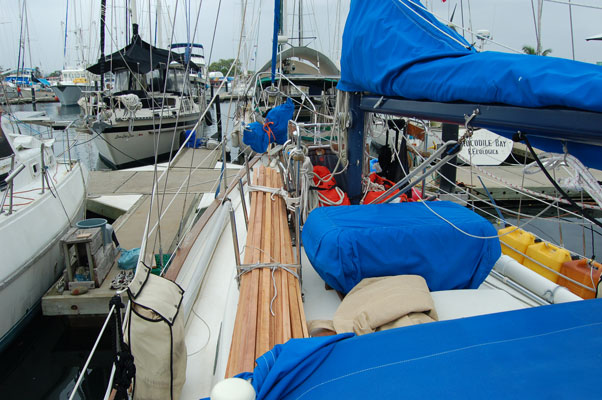
Next, 15 gallons of primer paint. The primer came in weeks before the wood so Tracy had already loaded it into the dinghy and taken it from town to the marina fuel dock, where they stored it until we left.
Did we mention that it's been raining lately? We moved Landfall from her slip to the fuel dock to get the primer, hoping to get fuel as well, but we can't fuel up in the rain because our fuel fill is under water when it rains. And it started pouring just as we pulled up to the fuel dock. So after loading the primer aboard, we filled three jerry jugs with diesel to pour into the main tanks when things dried out.
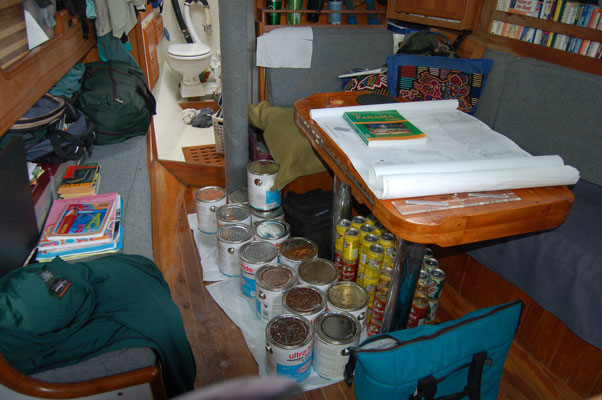
Finally all loaded up, we set out around 1pm. Friends Paula and Patrick Gallagher aboard Barefoot, their Irwin 43, followed us, in heavy rain that soon eased to a drizzle.
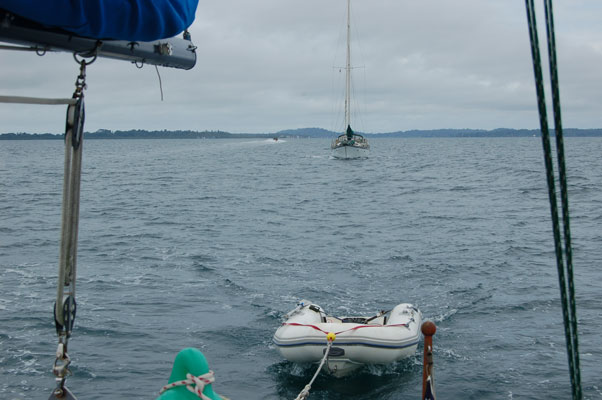
Although the rain continued over the mainland, it eventually stopped over Almirante Bay for the three hours it took us to motor the twelve miles to Darkland.

We chose a route that kept us in as much deep water as possible because with overcast skies it was impossible to judge the water depths, and the many shallow reefs were invisible. We motored because when the wind wasn't on the nose, we were in too narrow a channel to want to be sailing so close to those reefs. We'd plotted in GPS waypoints based on our main charts as well as the small charts in our cruising guide, and they proved accurate enough to keep us in deep water right up until we got close to the house.
The scenery along the way was typical tropical rainforest, with a few small homes and farms breaking the green blanket of jungle. We sailed down the west side of Isla Cristobal and navigated a long narrow channel southeast of Bermudez Point. When we entered Laguna Palos, also called Darkland, also called Tierra Oscura, we could see the big metal roof bright across the bay, and headed for it.

We knew there was a reef system right in front of the house, but our memories of exactly where it was turned out to be a little fuzzy! After a few close calls with the reefs, we got securely anchored, much further off the shore than we'd expected to be.
The neighboring house appeared abandoned, but the local caretaker family was there, hanging out on the shore.

Once we'd settled in the skies opened up again, but by then it was sundowner time, whether the sun was out or not! Paula and Patrick had dropped their hook close by, and in the rain, we all made an early night of it.
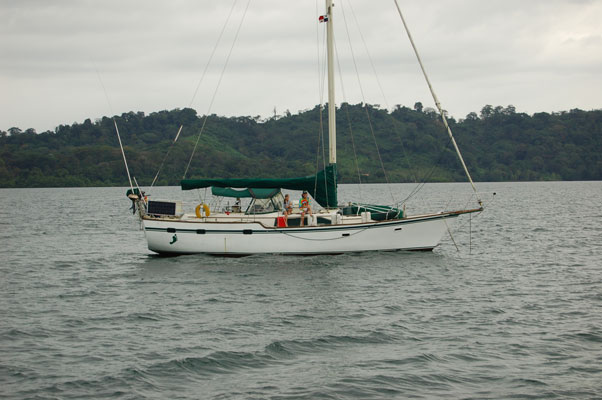
By morning the rain had stopped, and all the supplies had to be offloaded. First, the primer.
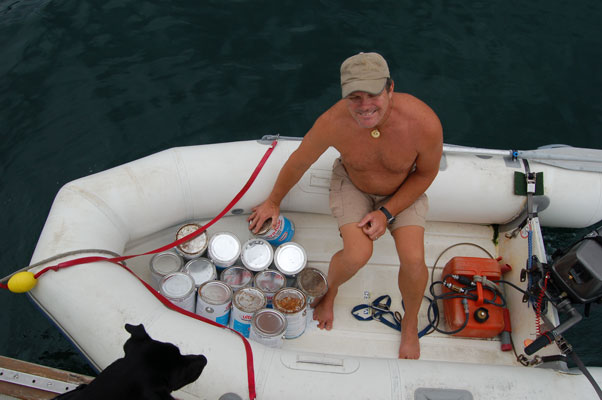
Next, the wood.

Eventually, all is delivered.

Exploring the Jungle--Sort of
A launch came up to us the next afternoon, with three gringos aboard, a man and two women. They introduced themselves as Jim, Dorothy and Marcia, our neighbors at the head of the bay, and invited us to use their dinghy dock and to walk the trails on their property any time we'd like. "Well that's friendly," we thought.
We had no idea that their "trails" would turn out to be three foot wide wood chip trails, in better shape than most state park trails, meandering for miles across the whole peninsula! It was like walking around our own private nature preserve! At least eight workers seemed to be working at any given time during the week, creating and maintaining the trails, landscaping and grooming the grounds. Fruit trees were in abundance: banana, cacao, fig, mango, coconut, and a whole lot more that we couldn't identify. There were a few acres that had been planted in teak a while back, but most of the property was allowed to just be jungle. Some jungle had been cleaned up a bit to showcase the heliconias, orchids and all manner of epiphytes. Although relatively common, this one is still Sharon's favorite.

Some of the trees are forest giants that could swallow Gellie up whole in their buttress roots. I wonder what's in that root cave?
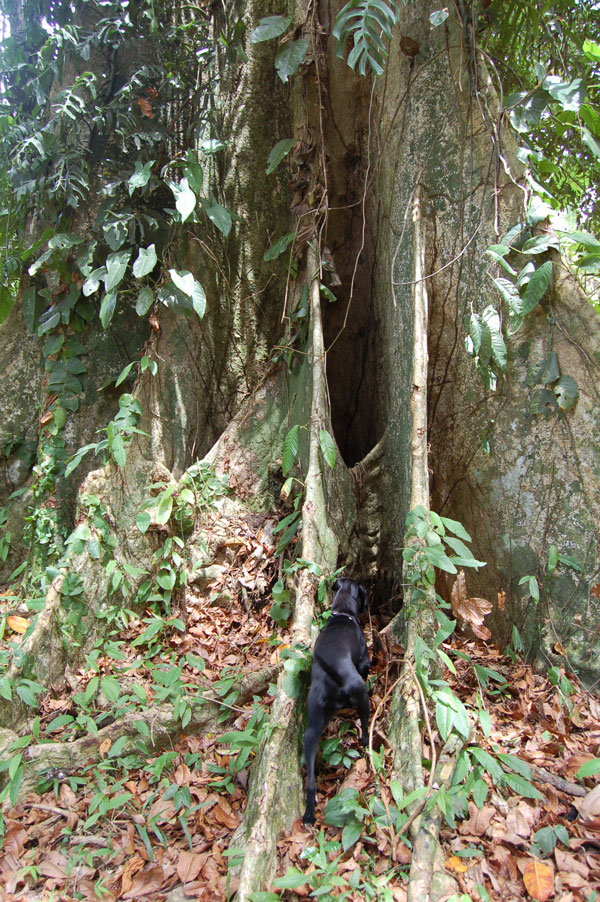
Heck, some roots were higher than our heads!

Hiding out in a cacao pod pile were many little poison dart frogs. Hard to see at first, but can you say "Don't lick these"?
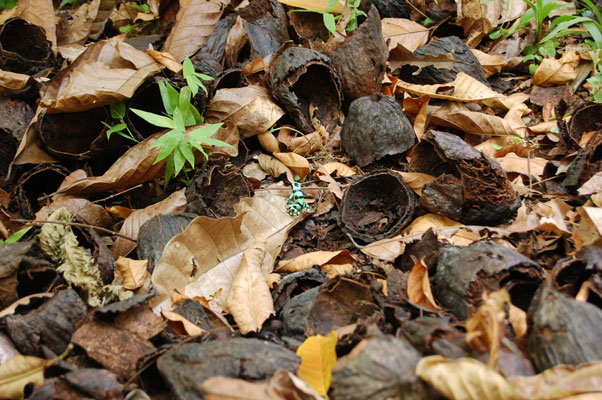
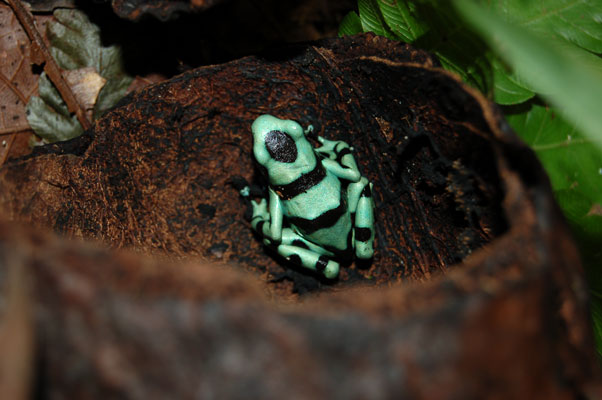
We had heard howler moneys occasionally from the boat, but never saw them while on shore. One day on our walk we heard things clunking to the ground around us and discovered partially eaten figs dropping from the treetops. We hoped it might mean monkeys overhead. It turned out to be a flock of parrots. Still pretty cool, but we were hoping for monkeys! Gellie discovered that the figs tasted pretty good, and had herself quite a snack.
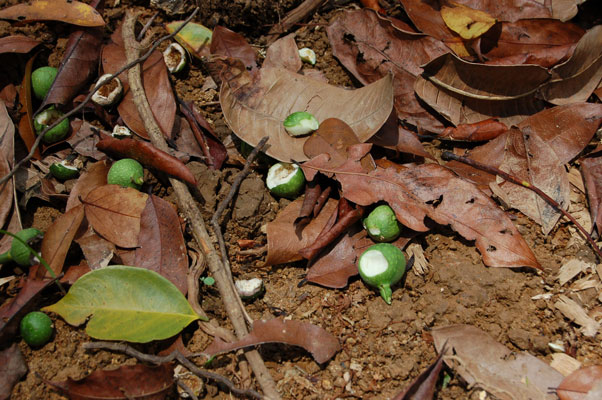
And it wasn't all just plants and birds; how about this guy waiting for lunch beside the trail?
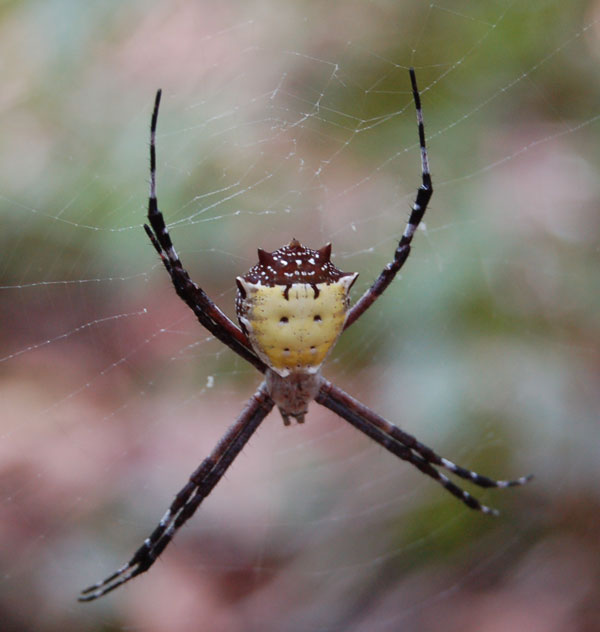
It takes an hour to walk the whole trail system, and we walked it many times in the two weeks we were there. Along the trail are four different bays, with varying size docks. The big dock, being built to accommodate their 48' Hatteras fast cruiser, is going to look like the entrance to a Disneyland Pirates of the Caribbean ride!
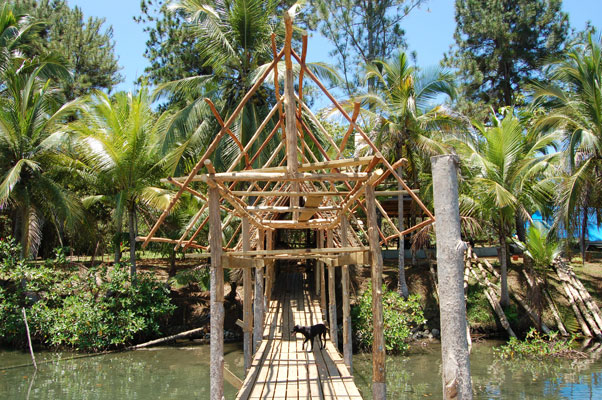
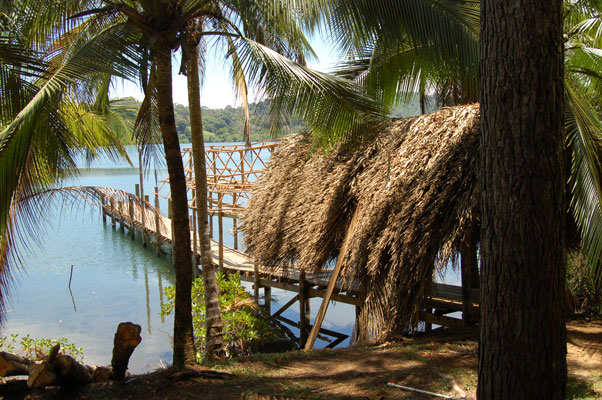
We are extremely grateful for their generosity in letting us explore their land. Gellie is especially grateful to have so much room to explore unleashed. And to add to our appreciation, they've told us that most all of the land will be put into a trust to protect it from development. Our kindred spirits, for sure!
New Visitors
A couple of days after Barefoot left, Angel Heart, with Paul and Mary Margaret Fitch aboard, arrived in Darkland on their Gemini 33 catamaran. Unlike us, they didn't have to worry very much about the route down, since they only draw 18 inches of water!
Paul loves to cook and tries to make each meal better than his last, so we had a wonderful time exchanging appetizers and dinners on our respective boats. The potluck bar has definitely been raised, a circumstance much to all our pleasure!
On
Angel Heart's last
morning in Darkland we got into our dinghies and took a tour of Palos Lagoon. It turned out to be even bigger and more beautiful than we'd thought.
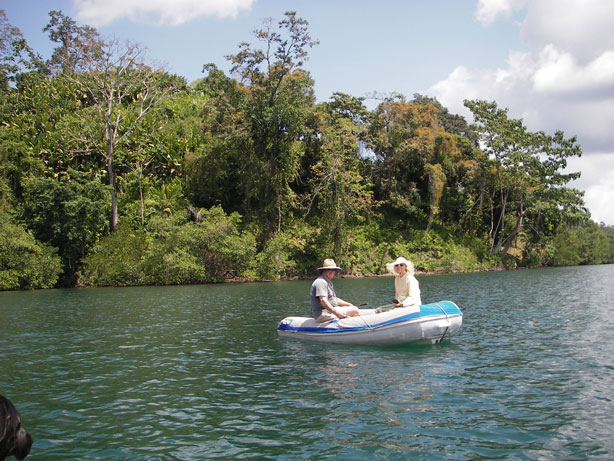
After two hours of "dinking around" we were all sun-baked, and headed back to the shelter of our big boats.
Though Angel Heart had to return to Bocas to do some mainland chores, we stayed on. Mary Margaret had introduced us to her friends Carl and Mary Heckrotte, who live in nearby Dolphin Bay. Mary and Carl had dinghied over to Landfall for snacks one afternoon, and then Mary invited us to participate in a uniform-giving at the Dolphin Bay primary school, Buena Esperanza. After handing out the uniforms, we could take a hike across the Loma Partida peninsula to the middle school in the indigenous Shark Hole village. Events worth staying for, for sure!
BESO at its Best
Given Landfall Learning's educational goals we are more than happy to participate in any way we can to try to understand the barriers children face in trying to get an education here in Bocas. In Panama, children must have a uniform to go to school. Many children in this area live in families unable or unwilling to afford the $25 cost of supplies that allow a child to attend school for a whole school year.
BESO, the Bocas Educational Service Organization, plays a big part in helping more and more kids go to school. Mary, a gracious and gregarious woman, plays a big role in BESO's activities. She is determined to see that any local child who wants to go to school, can go to school. It doesn't take much: a uniform, a backpack and a few notebooks, and the barrier to education is eliminated. On the morning she invited us to make her rounds with her, we dinghied over to Dolphin Bay from Darkland, a 20 minute ride in our little dinghy, and met her at her dock.
Then we loaded up her panga and drove the quarter mile from her dock to the school's dock and off-loaded the supplies that would distribute 29 uniforms and backpacks, and other classroom materials.
Maybe we should mention that there are no roads down in this part of the country. The only way around is by boat or along a very few rugged footpaths.
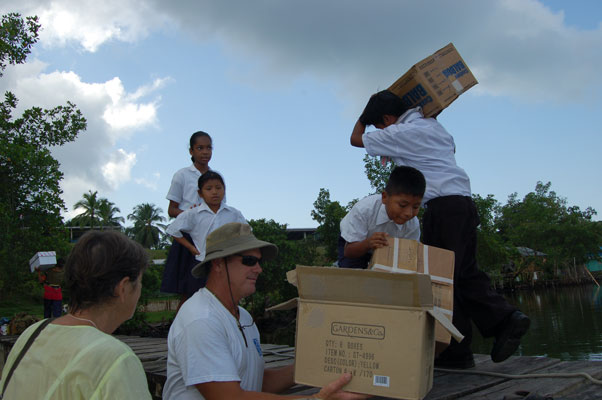
While the kids were waiting for Mary and the teachers to distribute the supplies, Tracy liberated a soccer ball from one of the boxes and started kicking it around with some of the kids. He makes friends so easily!
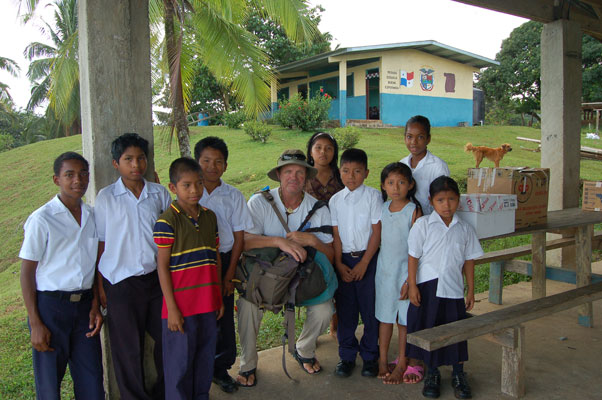
Finally, the teacher and Mary convened, and distribution began. Later, Mary said she felt like Santa Claus. I know the kids felt like they were having an early Christmas, too!
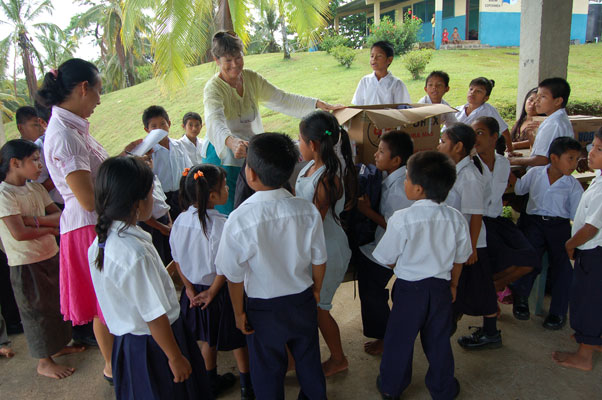
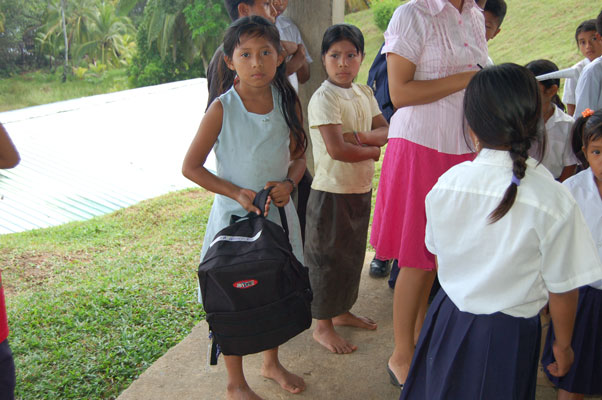

The initially shy but soon friendly and grateful children tore our hearts open.
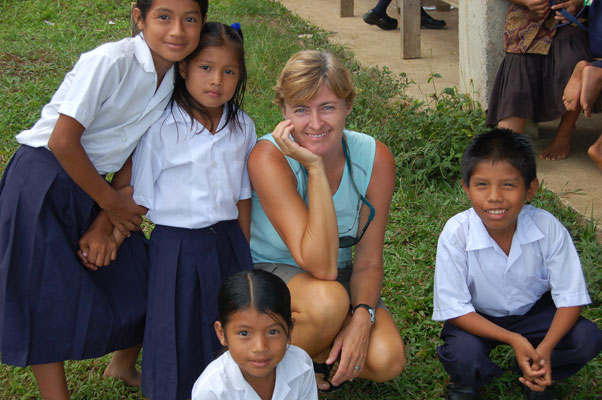
We dinghied back to Mary and Carl's boat, Camryka, where Mary fixed us a delicious lunch of homemade rolls topped with smoked salmon, red onion and fresh tomato, and then we gathered up with her neighbors and took a long, hot hike across the peninsula to Shark Hole village to see what the situation there was with the middle school kids.
Mary wrote this article for the Bocas Breeze, the local monthly newsletter here, and was generous enough to share her e-file with us, to co-publish here.
A HIKE FOR BESO
By Mary Heckrotte
For a year now, we’ve been living in Dolphin Bay, 8 miles south of Bocas. During this time, we’ve seen many outstanding individuals demonstrate their commitment to BESO, the Bocas Educational Service Organization. We’ve also seen first hand the help that BESO provides. For example, at the primary school located in Buena Esperanza, the village near us, neighbors George and Sue Hemming are sponsors for a BESO-funded project to build a new teacher’s residence and BESO purchased uniforms and school supplies for 29 kids as well as some classroom materials. But what about children who want to continue their education past primary grades? In Buena Esperanza, there is nothing. The middle school – seventh through ninth grades – is across the peninsula in a village called Shark Hole, an area so remote it is unclear even on Google Earth. Each school day, about 11:30, 10 or 12 kids paddle their cayucos across the Bay, park them in mangroves on the east side, then set off for Shark Hole School. They return around 6:00 pm, one fellow singing at the top of his lungs, rain or shine, as he paddles homeward. “Just how long does it take to get to your school?” we ask. “About half an hour,” they reply. A group of neighbors and I decide to take the hike to see this Shark Hole School.
The trail is up hill and down, through pastures and jungle, under the cacao tress, over creeks, and across swamps where big sticks are required to balance on the bits of rotten logs well worn by years of bare feet. The red clay mud is slippery, like walking on spilled egg whites. And this is the dry season. Imagine hiking to school on the days when tropical downpours drench heaven and earth. Neighbor Judy Green, who grew up in these parts and knows the area and its sounds, warns us when she hears a deadly Bush Master moving off the trail, out of our way. Yikes! We are relieved to see the first thatched roof as we again approach civilization. For my old body, this hike has taken 51 minutes of puffing and panting in the swelter of mid-day jungle heat. And then there’s all the way back.
Jonas Palacio and Rosaura Hooker are two young people from Buena Esperanza who go to school at Shark Hole. Their fathers have no work so are not able to afford the mandatory school uniforms and supplies. Yet both are bright and sufficiently motivated to continue their education. Thankfully, BESO raised $25,000 at their 2008 Annual Charity Auction and so they can say yes to help for kids like Jonas and Rosaura. BESO bought each of them 2 pants/skirts, 2 shirts, shoes, back pack, and 10 notebooks. Less than $50 each, a very small outlay of cash for such a big return.
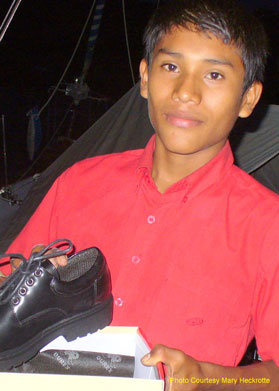 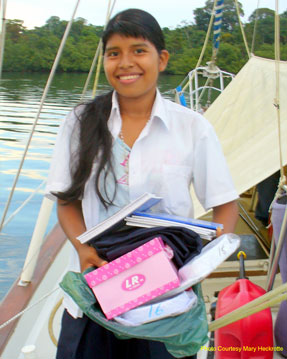
Jonas and Rosaura, like the other kids, set off in everyday clothes, saving uniforms to be fresh for class. There’s a big tree close to the village where boys stop to change, stuffing grubby clothes in the tree limbs until they return after classes. The girls change behind a tree further off the trail. The kids, especially the girls, travel in groups. Even so, some of the fathers in Buena Esperanza will not allow their daughters to attend school at Shark Hole, fearing for their safety along the trail.
We arrive at the school just as the older children have assembled to hoist the flag, right hands raised as they sing the Panamanian National Anthem. The school building at Shark Hole does double duty with 3 primary classes meeting in the morning and then 3 middle grade classes in the afternoon. The building appears to be in good condition with a rainwater collection system, kitchen for preparing lunches (often the only hot meal a child gets each day), and even a small library. The school’s six teachers come from other parts of Panama and, since Shark Hole is far too distant to commute from anywhere, even Bocas, they live in the village in housing provided by the government.
My neighbors and I tell the teachers about BESO and ask if there are children who are missing classes because they don’t have the required uniforms. Oh, yes! The teachers will make a list of names with uniform and shoe sizes. One teacher asks if BESO could purchase a set of encyclopedias for her class. They all tell us they need books and pencils and dozens of others items the government is not able to provide. They will compile a list, send their request. And the good news is that BESO can help.
As the 2008 school year proceeds, requests continue to roll in from schools in the Bocas area and, thanks to the wonderful generosity of businesses and individuals, BESO is helping with many educational needs not covered by government funding. So far this year, BESO has said yes to:
- uniforms for 175 children
- 15 scholarships
- $1000 for Internet services for the high school in Bocas
- $2000 for a classroom building in Carenero
- $2,300 for building repairs at Escuela Tierra Oscura
- $929 for electrical repairs and supplies at Centro Parvulario Estado Israel
- $800 for first grade reading books for area schools
- and has $3,000 on hold for shipping costs for a full container of computers/books and fire and hospital equipment donated by World Care, Inc.
The hike to Shark Hole makes clear the amount of sheer commitment and effort needed for kids to pursue an education in Bocas. How can we do anything less than our best to offer them what help we can?
We have to agree with Mary; and it certainly was a challenging walk!
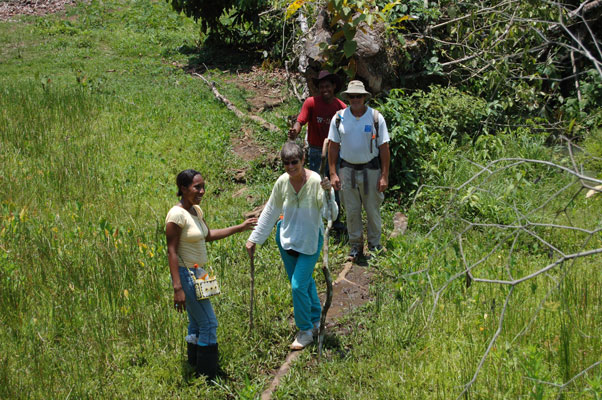
And the children in Shark Hole tugged equally at our heartstrings.

In many places, walking to school is not an option; there aren't even trails because it is all swamp. For these kids - and their parents - a panga is the SUV of choice. "All aboard!" ( U.S. parents, kind of makes you appreciate being able to just hop in the car to get the kids from school to soccer practice, doesn't it?)
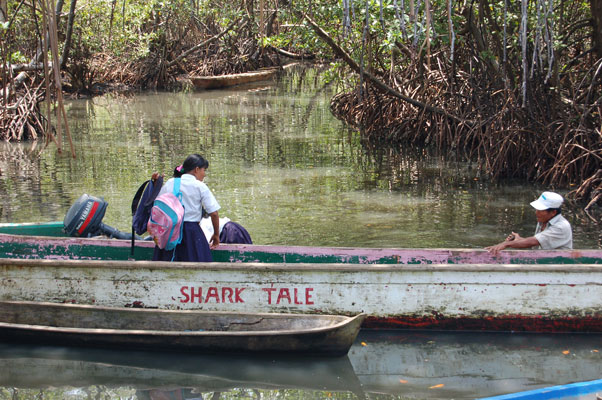

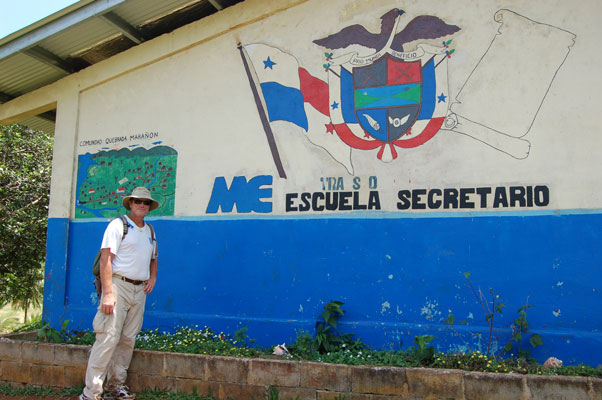
But progress has not completely bypassed these folks. While there was indeed a pay phone in the phone booth in the center of the village, cell phones were also in evidence, this one being used by Joe, Judy's son, who was one of our local "guides" for the hike across the peninsula.
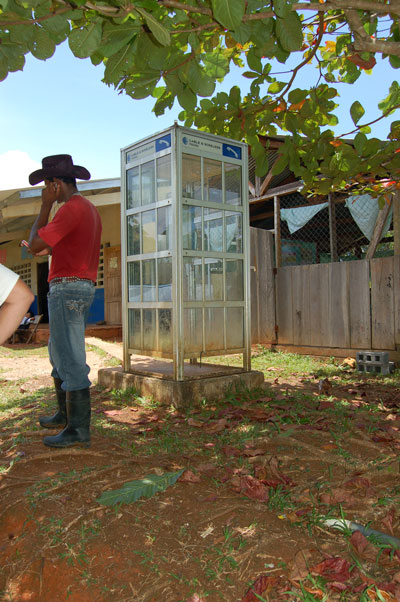
And they have obviously been introduced to Hollywood...
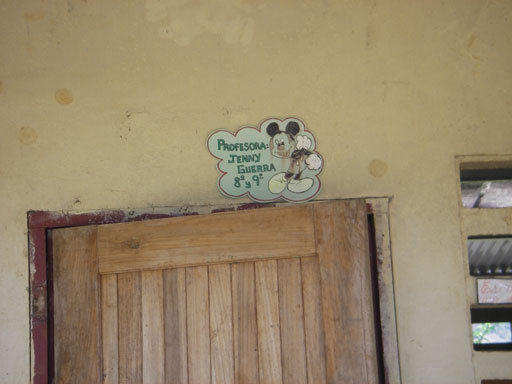
The walk back from Shark Hole was more leisurely, partly because we were all tired, partly because there was so much to see. These oropendula nests caught our eye. What intricate weaving those birds manage with just beaks and feet!
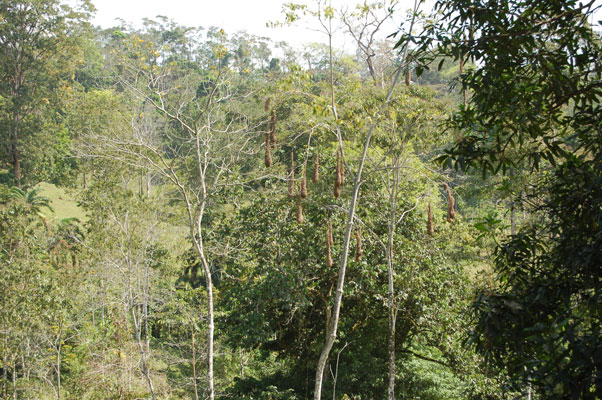
Judy pointed out a wide variety of fruit as we walked back: figs, plums, and an amazingly ugly fruit called a soursop. She broke a ripe one into pieces for us all to suck on. At first we weren't too sure; it was daunting: prickly, mushy, with stringy fibers and big black pits. But after one slurp, we were hooked: tangy, tasty, juicy, messy! She found another unripe one, and gave it to us. What a wonderful gift, as they are not available in markets anywhere.
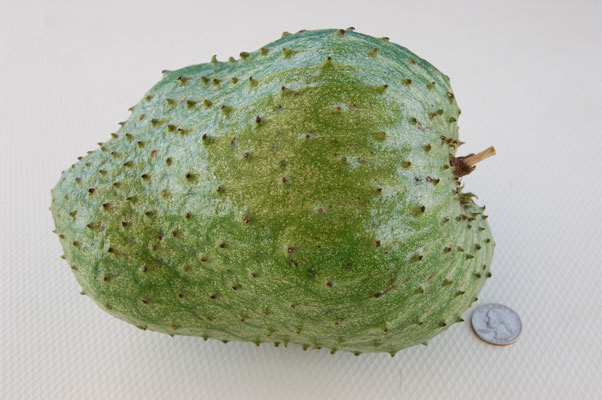
Getting Closer to Buying Some Land
On arriving back at Mary's place we continued on with Judy, who walked us around the 2.5 acres she has for sale next door to Mary and Carl's place. She pointed out the many fruit trees on the property: limes, oranges, lemons, coconuts, bananas, figs. The waterfront property rises to a high hill with a view of all of Dolphin Bay.
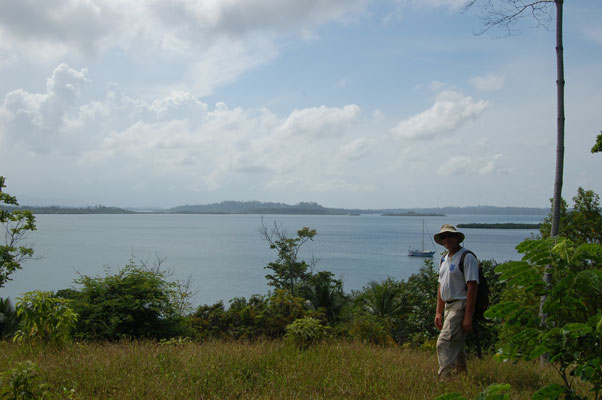
The logical house site up on top of the hill would have ample breeze and also let us pick lemons from the kitchen window. The hill is so high, Tracy is already thinking "zipline..." The water in front of the property is deep and the bay is protected from the prevailing winds. It's in our price range, and we already like the neighbors...hmmm...
Stay tuned for the next update!
April 20, 2008 BREAKING NEWS: We met with the owners and made an offer on Saturday, April 19, and it was accepted on the spot! There's a lot of paperwork to be done to finalize the transaction, but we think it can all be accomplished in a few weeks. More pictures of the property here.
|
![]()